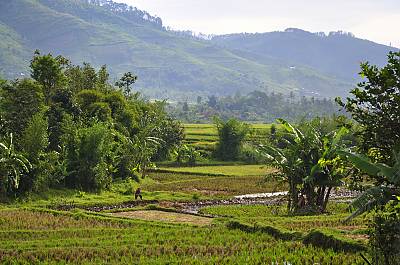- Indonesia


Javanese Pekarangan Homegarden System

© “from Bandung to Kutoarja” by Johan Wieland is licensed underCC BY-ND 2.0
1. ICH domains
Practices concerning nature and the universe
2. Short description
The pekarangan homegarden is a traditional system of crop cultivation, practised commonly in the countryside of Java in Indonesia. It combines annual and perennial crops on the land around the household, or in commons shared by several households. It serves as both a dwelling-place providing permanent source of shade for the house, and a source of food all year round. It is an ecological system involving interactions between human beings, plants, animals, soil, and water. As such, the intergenerational transmission of ecological knowledge relating to the pekarangan system is crucial to its success. Psychologically, it serves as protection and assurance in times of natural disasters and economic instabilities.
Homegardens are vertical in their orientation, with several layers or stories of plants. The lowest stories are comprised of starchy food plants, vegetables, and spices, such as sweet potatoes, chili peppers and cassava, while the upper stories are made up of fruit trees, such as papaya, banana and coconut. The homegardens also include medicinal plants, cash crops, and other trees for building and firewood. In addition, the system involves animals, including livestock, birds, squirrels, bats, civets and insects. The pekarangan homegarden originated in West Java and spread throughout the rest of the island in the 18th century. Today, it comprises 20 per cent of the land use in Java.
Further information:
The following articles describe the pekarangan system at length and its importance to the community’s sense of identity and continuity. The articles also outline current threats to the system’s continuity and viability:
http://dlc.dlib.indiana.edu/dlc/bitstream/handle/10535/4070/The_Javanese_Homegarden.pdf?sequence=1
http://archive.unu.edu/unupress/food/8F073e/8F073E08.htm
http://www.gerrymarten.com/traditional-agriculture/pdfs/Traditional-Agriculture-chapter-06.pdf
3. Link with sustainable development
The pekarangan homegarden system provides food security and supplemental income, while maintaining ecological biodiversity and carbon stock. It provides a regular food and nutrition supply to households as cultivation is carried out all year round, and the sale of surplus crops provides economic security. The homegarden system is thus closely linked to SDG 2, which aims to achieve food security and improved nutrition and promote sustainable agriculture. The stability and sustainability of the practice to ensure optimal use of the land all year round with a great diversity of crops and farm stock contributes to SDG 12 on responsible consumption and production.
4. Questions for reflection
Is there any evidence in the texts below that communities want to continue transmitting this practice? Are there any threats? If so, how could they be addressed?
Do you know of similar examples? What was done to safeguard them?
https://www.researchgate.net/publication/284422504_Village_forest_gardens_in_West_Java
http://www.sciencedirect.com/science/article/pii/S2212041613000533